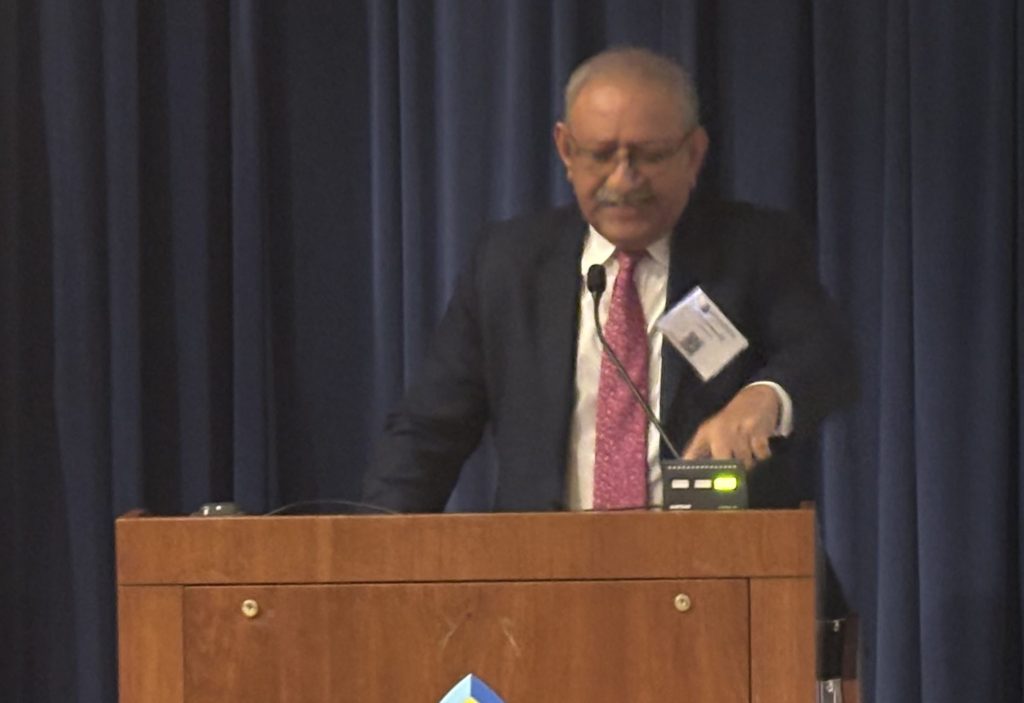Stephanie Zhang
Richmond Woodward
Mass Eye & Ear
The ocular oncology session began with a presentation on radiation retinopathy given by Dr. Arun Singh. Radiation retinopathy responds to anti-VEGF agents and corticosteroid treatment. However, it can spontaneously improve, confounding clinical treatment trials. While progress has been made in understating and treating radiation retinopathy, key knowledge gaps remain including which patients to treat, how often to inject, and which agent to use first. Dr Singh described a clinical trial in conjunction with the DRCR Retina Network designed to help answer questions regarding treatment for radiation retinopathy, in particular preventative treatment. One trial in progress compares long term visual acuity outcomes in eyes with choroidal melanoma initially treated with repeated anti-VEGF or long-acting steroid compared to eyes initially observed and treated with faricimab only if macular edema developed.

Dr. Jasmine Francis then gave a talk entitled, “Updates on Retinoblastoma and Histiocytosis.” She began by highlighting the symptoms of ocular histiocytosis and how traditional biopsy can be difficult due to risks inherent in biopsy of the brain/eye and scant histiocytes present. However, studies of cell free DNA (cfDNA) in the blood have shown how cfDNA can be used to establish the diagnosis and bypass limitations associated with biopsy. Another advantage of cfDNA is that is can be used to determine the mutational profile to best develop a treatment plan.
Dr Francis then discussed retinoblastoma and how the management and survival rates have been transformed by intraarterial chemotherapy. Research has shown serum RB1 cfDNA may play a role in guiding treatment of patients following enucleation for retinoblastoma as increasing levels of cfDNA may be associated with the development of metastatic disease. Intravitreal topotecan is also under study as an alternative to melphalan, which may have retinal toxicity, for the treatment of retinoblastoma vitreous seeds.
![]()
The next talk on evolving treatments in uveal melanoma featured Dr. Carol Shields who highlighted several exciting updates in the field. Two new biomakers in uveal melanomas—BAP1 and Tenascin C—may have prognostic value for disease specific survival and be cheaper and quicker than traditional DNA analysis. She finished her talk discussing four prospective trials that are promising for either tumor control (BelSar for small choroidal melanoma), visual prognosis, preventing metastasis (Tebe for medium sized melanoma; Daro for medium to large choroidal melanoma), or decreasing postoperative macular edema from radiation retinopathy (DRCR protocol AL).
The final session of the morning featured Dr. William Mieler who gave an excellent summary of the retinal toxicity associated with oncology drugs. He gave a well-organized talk featuring newer immunotherapies like mitogen activated protein kinase (MEK) inhibitors, check point inhibitors, anaplastic lymphoma kinase (ALK) inhibitors, and more. Additionally, the toxicity of more well-known medications like tamoxifen to less well-known medications like epidermal growth factor receptor (EGFR) inhibitors were discussed. With so many new oncology drugs emerging in the market, many with ocular side effects, this talk was definitely a well-timed reminder to stay alert of potential new ocular associations in the future.
Read All Atlantic Coast Retina Club / Macula 2025 Articles:
Mystery Cases 1 & 2
Mystery Cases 3 & 4
Mystery Cases 5 & 6
Mystery Cases 7, 8, 9
Imaging, GA, and IRDs
Keynote Lectures
DR and DME
Choroidal Neovascularization
Retinal Vascular Diseases
Ocular Oncology
Special Topics & Women in Retina